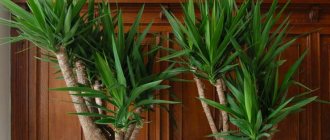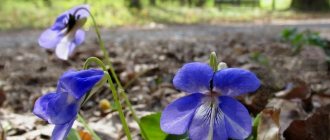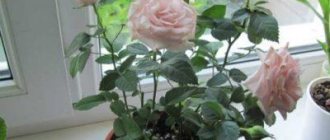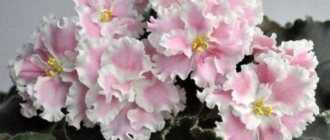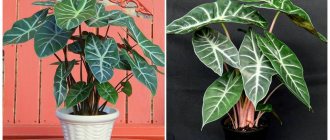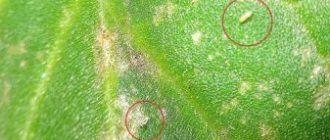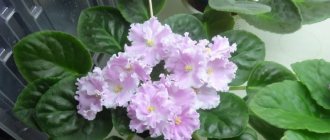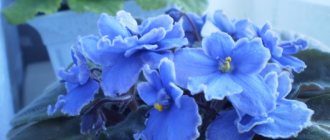Flower growers often call Saintpaulias the queens of window sills . A well-groomed violet, like no other indoor plant, can decorate any room with year-round flowering.
Having learned the characteristics of the variety, you will not encounter the unexpected vagaries of a delicate flower.
And by immediately organizing the correct care for your indoor flower, you can easily get gorgeous and abundant blooms , spending a minimum of time and effort.
Uzambara violet RM-White Sails (N. Skornyakova)
History of the variety
The varietal Uzambara violet RM-White Sails was bred by breeder Natalya Skornyakova , belongs to the Gesneriev family - Saintpaulia. In 2015, the grown seedling of the domestic breeder Natalia Skornyakova was named RM-White Sails .
In front of the name of the variety, there is a distinctive prefix of the breeder RM. These letters are not a random choice - the initials of Natalya’s mother; she dedicates all the Saintpaulia varieties bred by Skornyakova to her mother.
Natalya herself comes from the city of Kursk . She fell in love with violets since childhood, and about 10 years ago, Natalya Skornyakova began breeding Saintpaulias.
Photo and description of the variety
The elegant, delicate variety of Natalia Skornyakova quickly became a favorite in many collections . Violet RM-White Sails - standard, rosette diameter ranges from 25 to 35 cm, depending on growing conditions. Socket:
- Flat;
- Symmetrical;
- With bright green leaves that have a slight edge.
Delicate violet White Sails.
The variety blooms profusely , with large semi-double and double white stars with slightly elongated petals and a yellowish center.
Variegation, imprints
The variety RM-White Sails does not have variegated foliage or imprints on the petals. The rich green leaves highlight the amazingly delicate wavy flowers.
Winter care
The Buckeye Seductress violet plant came to us from the south, and therefore needs additional lighting in the cold season. If possible, it is worth purchasing a small fluorescent lamp for the flower. But you can simply turn on a chandelier or lamps in the evenings in the room where the flower is installed. Buckeye Seductress should not be watered too often in winter. In any case, you should not allow water to stagnate in the pot. Otherwise, the roots of the violet will definitely rot by spring.
The variety does not tolerate low temperatures well. If it is cold on the windowsill, it is better to remove the flower from it to a more suitable place. In winter, the air in rooms is usually very dry. Therefore, under the pot with violet it is worth placing a tray with expanded clay and water.
Buckeye Seductress is a violet, the photo and description of which are described in detail in this article. This plant is quite unpretentious. It is no more difficult to care for than any other variety. His appearance is, in fact, very original and elegant. With timely watering and fertilizing, as well as choosing the right place, Buckeye Seductress will certainly please its owners with spectacular long-lasting flowering.
Caring for a plant at home
For the growth and development of each indoor flower, certain conditions are required .
Important factors for Saintpaulias: In rooms with insufficient indicators for these factors, violets may die.
Conditions of detention
grows remarkably well :
From spring to autumn, you need to protect the plant from scorching sunlight. For violets, light is important , but it should be:
For good flowering, violets require proper care.
When placing on a windowsill, it is better to give preference to a window located on the eastern or western part of the house or apartment.
Proper watering and fertilizing
Violet RM-White Sails is watered with settled water at room temperature. In cold weather, the frequency of watering should be reduced. The flower at this time requires less moisture, and its excess will stagnate in the ground, which is why the delicate roots will begin to rot.
Saintpaulias can be watered from above.
The plant needs to be fed at least 2 times a month during flowering. If the branches have already faded, then fertilizing with complex fertilizer is carried out once a month.
To feed violets, use a special complex fertilizer “For primroses and violets”; if you use another universal fertilizer for indoor flowers, the dose is reduced by four times.
Lighting and temperature
RM-White Sails, like all Uzambara violets, is a heat-loving flower . The room temperature should be kept within +18..25 °C, and in no case should it drop to +16°C.
The violet does not tolerate the hot summer heat very well;
it is used to cool the air in the summer:
But, it is necessary to take into account the fact that the flower is afraid of drafts , so the air flow should not be directed towards the violet.
High temperatures lead to a slowdown in photosynthesis in the Uzambara violet; at temperatures above +26 C° Saintpaulia :
- Stops growth;
- And the center of the socket gets clogged.
If in winter the Saintpaulia stands on the window, and there is no way to put it in another place, then you need to insulate the glass and place it on the windowsill:
- Styrofoam;
- Or a special thermal insulation material that does not allow the cold to pass through.
How does air humidity affect a plant?
The humidity level in the room is very important. Violets feel great when the humidity in the room ranges from 60-70% . Saintpaulias do not tolerate dry air very well, this is especially true in winter, when heating is on in apartments. Heaters dry out the air greatly, and nearby flowers suffer greatly.
For Saintpaulias it is necessary to humidify the air.
During the period when the heating is on :
- Containers with water are placed near the violets;
- Or use an automatic humidifier.
What soil do you prefer when growing at home?
Violet RM-White Sails is grown in slightly acidic nutrient soil , and it must be well permeable to moisture and air. To grow Saintpaulia at home you can:
- Buy special soils for violets;
- Or prepare the soil yourself.
To prepare the soil you will need :
- High-moor peat – 3 parts;
- Nutritious flower substrate – 2 parts;
- Raising agents perlite, foam balls, sphagnum moss - 1 part each.
All of the listed components are poured into a deep container and mixed . Store such soil in a closed container to avoid overdrying of the finished substrate.
Pruning and hygiene
To form a beautiful symmetrical rosette, they begin to care for the violet when they are young:
- Remove all asymmetrical leaves;
- The stepsons formed in the axils of the leaves are carefully pryed with a toothpick and removed;
- Carefully cut off juvenile, diseased, old or yellowed leaves with a scalpel or break them out with your hands.
For good growth of the variety, it is necessary to remove damaged parts.
Reproduction methods
The Usambara violet variety RM-White Sails, like other Saintpaulias, is best propagated:
The best time for propagation by leaf cuttings is spring . Leaf cuttings planted in the ground quickly produce strong offspring, and after 6 months you will get a strong starter.
Transplant rules, rejuvenation
Grown-up children and starters of violets are transplanted into large flowerpots using the transshipment method , trying to preserve the earthen ball entwined with roots as much as possible.
to rejuvenate an old violet :
- A small bare stem is deepened into the substrate to the lower leaves, and part of the roots are removed;
- If the violet trunk is more than 2 cm, then it is cut off, leaving a small stump, and the trunk is peeled like a carrot. Then they are placed in water for rooting or immediately planted in new soil and placed in a greenhouse until new roots form.
How long does it take to grow an adult plant?
From the moment the leaf cuttings are planted in the ground until the babies appear, the passage takes about a month on average . After 2-3 months, the grown-up children are separated from the mother's leaf; on average, six months pass from the moment the child is transplanted until the formation of an adult rosette.
The variety grows and develops very quickly.
Attention! Sometimes a young starter can delight with the first flowers after 5 months.
Is it possible to achieve cap flowering?
The very first flowering is usually not a cap; the young rosette produces only a few peduncles , on which several flowers are located.
Violet has cap flowering.
But an adult specimen, when it has gained the required amount of green mass, with good care, in the second flowering already pleases with a dense cap of snow-white flowers .
Where to put
Like all other varieties, Buckeye Seductress violet prefers bright light, but does not tolerate direct sunlight. Therefore, it is best to place it on the north window. Sometimes Buckeye Seductress is placed on the east or west, after closing the glass with thick curtains.
The air in the room in which Buckeye Seductress is supposed to be grown should be quite humid and warm. Most often, experienced indoor plant lovers install this elite violet in the kitchen. In this room, and especially during cooking, the Buckeye Seductress has ideal conditions in terms of heat and humidity.
Under no circumstances should this plant be installed in a draft. Otherwise it will definitely start to hurt. In order for the violet rosette to always have a neat shape, the flower should be turned to the light with the other side about once every two weeks.
Violet white sails photo and description
Skornyakova N., 2014, Very large simple, semi-double and double wavy-fringed white stars with slightly elongated petals and a yellowish center. Abundant flowering. Smooth rosette, green leaves. (Author's description).
Very large simple, semi-double and double wavy-fringed white stars with slightly elongated petals and a yellowish center.
Some objects posted on the site are the intellectual property of StoreLand. The use of such objects is established by the current legislation of the Russian Federation.
The StoreLand website contains links that allow you to go to other sites. StoreLand is not responsible for the information published on these sites and provides links to them only to provide convenience to visitors to its site.
Personal information and security
StoreLand guarantees that any information received from you will never, under any circumstances, be provided to third parties, except in cases provided for by the current legislation of the Russian Federation.
In certain circumstances, StoreLand may ask you to register and provide personal information. The information provided is used solely for official purposes, as well as to provide access to special information.
Personal information can be changed, updated or deleted at any time under Account > Profile.
To provide you with certain types of information, StoreLand, with your express consent, may send informational messages to the email address specified during registration. At any time you can change the subject of such mailings or refuse it.
Like many websites, StoreLand uses cookie technology, which may be used to promote our product and measure the effectiveness of advertising. In addition, with the help of this technology, StoreLand is configured to work with you personally. In particular, without this technology it is impossible to work with authorization in the control panel.
The information on this website is for informational purposes only and is subject to any changes without any prior notice.
To opt out of further communications with our company, change or delete your personal information, write to us via the feedback form
Peculiarities
The white violet is a herbaceous houseplant that is characterized by its lack of a central stem, short stature, and longevity. The leaves of the flower have a dense structure; during the process of growth, they form into a basal rosette. The main feature of violet leaves is their pointed oblong shape; as for the color, it can be either dark or light green. In some species of white violet, the leaves have a spotted pattern; this flower is also called Saintpaulia.
Indoor violets differ in shape and flowering period, and their color can be either plain snow-white or patterned with a border or speckled. If the plant is given good care, it will “thank you” with long flowering, which often lasts up to 10 months. At the end of flowering, the violet produces a fruit in the form of a box filled with small seeds. They are quite suitable for sowing for two years. As a rule, violets of this type begin to bloom in the spring, at which time the first single buds, oval in shape and consisting of five petals, bloom.
White beauty usually has a height of 15 to 40 cm, it all depends on the varietal characteristics of the plant. Violets have a special structure of the root system - their roots are woody and thick. The stems of the flower are slightly shortened, they grow slowly, so the leaves are located tightly to each other, forming a lush rosette. The root system includes not only the greenery itself, but also the flower stalks of the crop.
The flowers, leaves and stems of the plant have medicinal properties; they are considered good antiseptics and help with kidney diseases, colds and problems with the gastrointestinal tract. This is due to the fact that violet accumulates many useful substances during its growth, such as vitamin C, rutin, salicylic acid and carotene. In addition, its greens also contain glycosides, which are necessary for the human body. Before using this flower for medicinal purposes, you should consult a doctor, since it also has a number of contraindications.
Today, many gardeners grow white violet at home, this is explained by its simple cultivation. In addition, there are also varieties of snow-white flowers that grow in parks, gardens and forests. In order for indoor culture to successfully develop and bloom, it is important to take into account the basic characteristics regarding the description of the species, and when growing, perform the following steps.
- Creating the correct shape of rosettes. The flower will take on a chic appearance if it is periodically turned clockwise towards the sun.
- Compact size formation. The bush needs to be pruned as it grows; to do this, remove the lower foliage. The result is a beautiful mini-bouquet, decorated with several rows of green leaves.
- Rejuvenation and propagation of an old bush. When the flower stem becomes too long, it should be cut off. This way you will be able to get new young foliage. To rejuvenate white violets, replanting is also used, using part of the rhizome with several leaves.
- Adding a bright shade to the flowers. Of course, white color is considered delicate, but if Saintpaulia is regularly watered with a solution prepared on the basis of potassium permanganate, you can get an unusual color.
Hello summer! Part 2.
As the great Carlson said: “Let’s continue the conversation!..” Dear violets, today I want to introduce you to photos of violets, which relatively recently began their victorious march through our windows and shelves, as well as portraits of beautiful varieties that have been living on the shelves for quite a long time , but I personally saw them for the first time. Maybe they will become a kind of discovery for you too. I’ll start with the new varieties that I managed to notice on the shelves. One of them is SK-Apple Garden, selection by Alexey Kuznetsov:
This is where the wonderful moment came to brag from the heart: I received a baby of this variety from the hands of Alexey himself! I really wanted to take a blooming rosette, but... the road... the road.. Ehh!..
The next photo didn’t turn out very well, although I tried very hard. The bells are simply amazing, but I probably didn’t take macro photography:
This is a miniature of SK-Landscape in the Fog.
And now - standards. Not super fresh, but still new for 2010, variety Sunset Kiss (LLG-Sorano), Simple dark lilac-pink perennial pansies with fancy blue, dark crimson wide border and thin white-pink edging around the edge of the petals. Light green, simple, quilted foliage.
In the foreground of the next photo you can see the outstanding size of EK-Divine Lotus flowers.
Huge double soft pink-peach-lemon flowers with dark pink fantasy. Although I did not purchase the variety, I added it to my wish list... The following rosette is LE-Curls of Venus (large bright cornflower blue semi-double pansies with a bright green ruffled ruffle. Medium green foliage):
One of Repkina’s recent novelties, RS-God of the Sun in full glory - Large double dark red flowers with a white border and wavy edge. Rounded medium green foliage, 2009.
Again a variety from Lebetskaya, LE-Don Corleone - dark purple terry stars with a cherry tint with a wide white border:
LE-Rose of the Winds - white semi-double stars with crimson ruffle, wavy light green leaves, new 2011:
Another new product for 2011, LE-Celtic Legend. The price per leaf inspires respect, although I would like more flowers...
One of K. Morev’s recent varieties, Dikovinka:
Variety K. Moreva 2010, Fire Moths - Dark red single or semi-double pansies with a wide red border or red and white. The border changes color as the flower blooms. The leaves are green. Small standard:
New by Elena Lebetskaya, LE-Dandy (large voluminous white-pink flowers, sometimes with a brighter fuchsia rich center, with green fringe, light wavy foliage):
The last of a series of recent new products, but, in my opinion, one of the brightest, LE-Macho. This rosette attracted many eyes, shining with the contrast of deep purple and bright white:
The flower in the foreground conveyed the color of the entire rosette very well. The photo was taken with a phone, but the color turned out to be real, oddly enough...Very large semi-double burgundy-violet-black stars with a clear white wavy border. Lush, abundant blooms on good peduncles above a medium green show rosette. New in 2010, but the price per leaf was quite steep. I'll wait...
In order not to tire the community on the eve of Sunday, I will postpone further review until tomorrow. I want to explain why I publish even not very good photos. It seems to me that this will help many beginners in compiling a collection, since exhibition plants match the varietal characteristics as accurately as possible and allow them to form a preliminary opinion about the variety. And my photos, although not always clear, convey color well (apparently due to good daylight in the shop windows).




